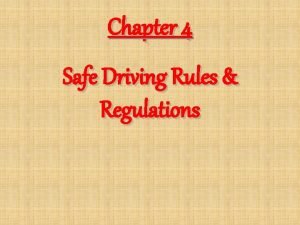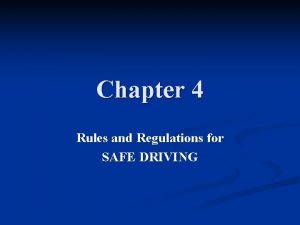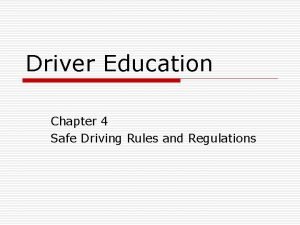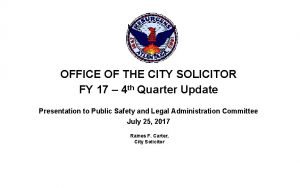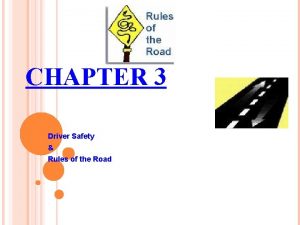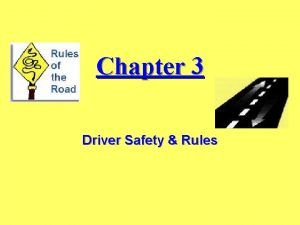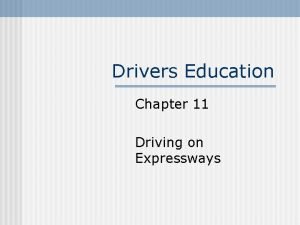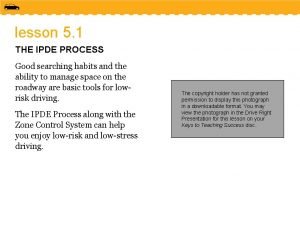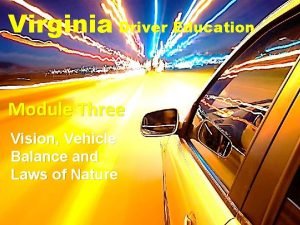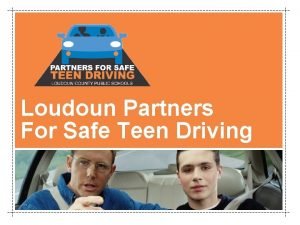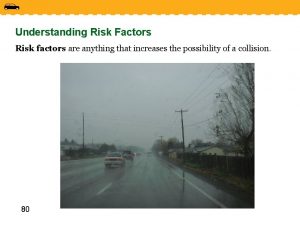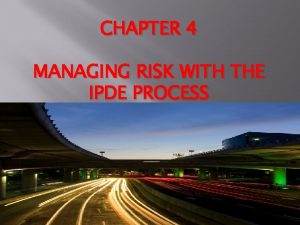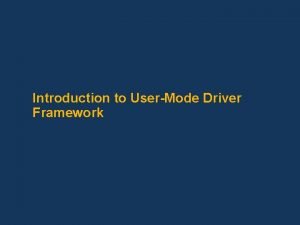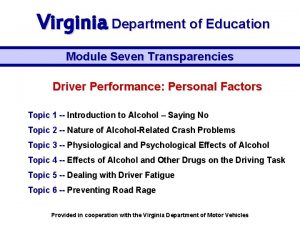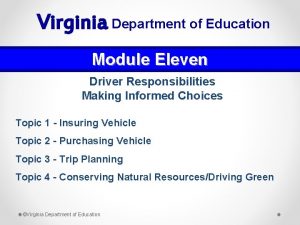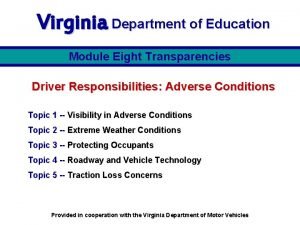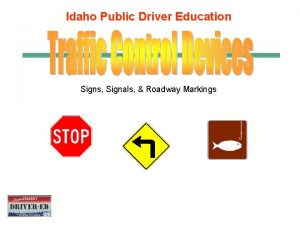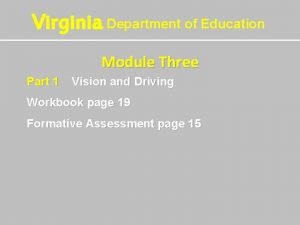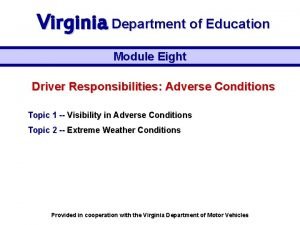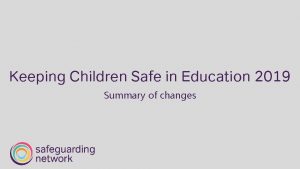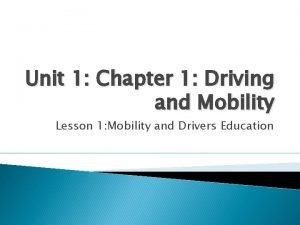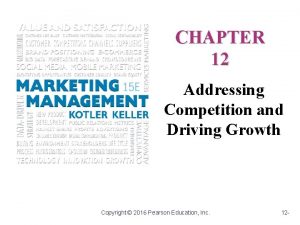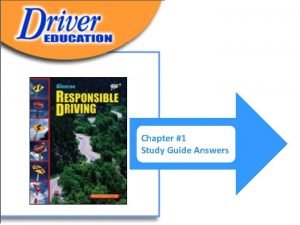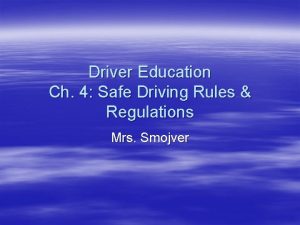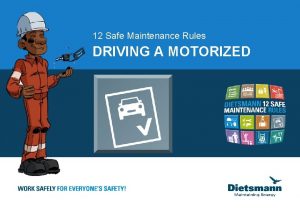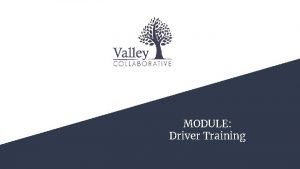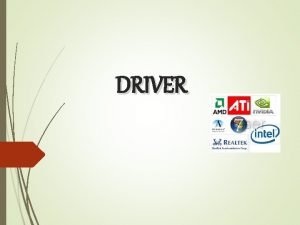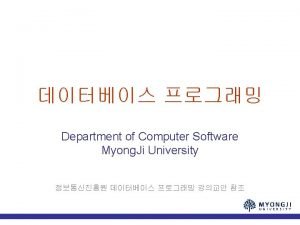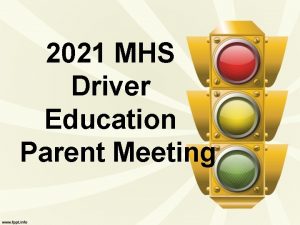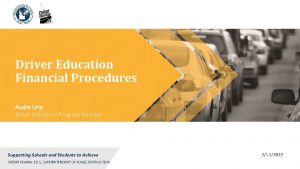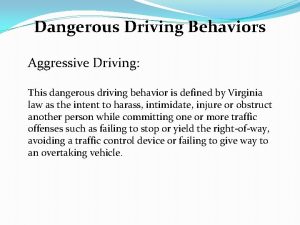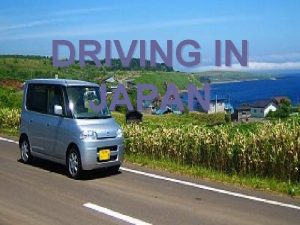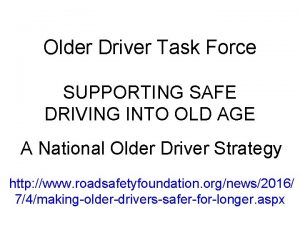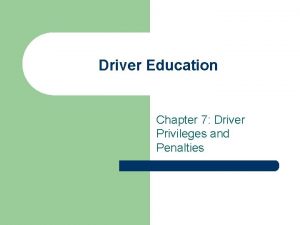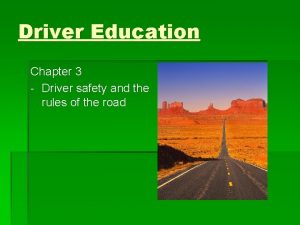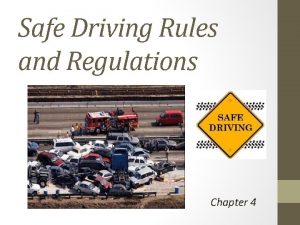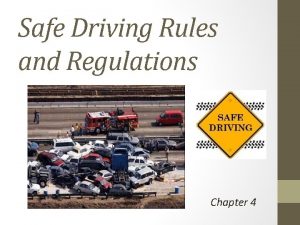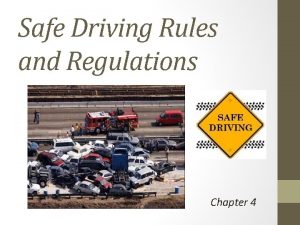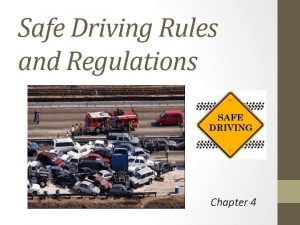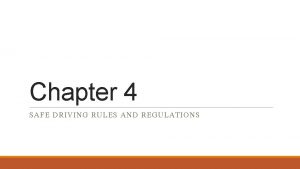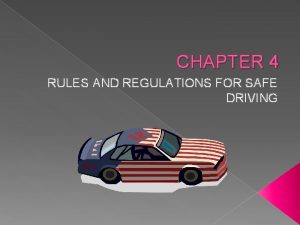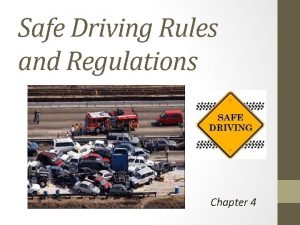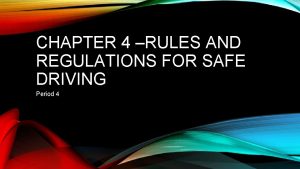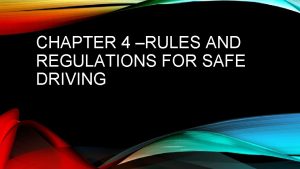Driver Education Chapter 4 Safe Driving Rules and































- Slides: 31

Driver Education Chapter 4 Safe Driving Rules and Regulations

Speed Limits o 25 mph 35 mph 50 mph 55 mph posted 65 mph - School zones, business or residential districts – Suburban business and residential districts – Non-posted rural roadways – Certain state and interstate highways, as – Certain interstate highways, as posted

Driving Too Slowly o A motorist should always try to keep up with the normal flow of traffic, while not exceeding the posted speed limit. Some collisions are caused by driving too slowly and backing up traffic. When road surfaces and traffic are normal, New Jersey law prohibits blocking traffic through slow driving. If vehicle problems prevent a motorist from keeping up with the normal flow of traffic, he/she should pull off the road and activate hazard lights

Passing o o o Both center lines are solid: No passing allowed. One center line is broken: Passing is allowed only on the side with the broken line. Both center lines are broken: Passing is allowed on both sides.

Pass only when safe Most passing should be on the left. Passing on the right is allowed only on roads with more than one lane going in the same direction or when the motorist ahead is making a left turn and there is room to pass. Never pass on the right shoulder of the road. A motorist should not pass: o On a hill or a curve or at any time he/she cannot see far enough ahead o At a street crossing or intersection o At a railroad crossing o On narrow bridges or in underpasses or tunnels o When a sign prohibits passing or center lines restrict passing o When behind a vehicle that has stopped to let a pedestrian cross o

Keeping to the right o o The laws of New Jersey require motorists to keep to the right, except when passing. Motorists must drive on the right half of the roadway unless driving on a one-way street.

Yielding the right-of-way o o o o Although laws govern the right-of-way, a motorist should always be prepared to yield. These basic rules always apply. Emergency vehicles: when police cars, fire engines and ambulances are giving warning signs (sirens, flashing lights) Buses: when re-entering the flow of traffic Postal vehicles: when vehicle is seeking to re-enter the flow of traffic Pedestrians: when in a crosswalk or seeking to cross a road Motorized or mobility-assistance devices: when in a crosswalk or seeking to cross a road Other vehicles that are already in the intersection

Pedestrians in a crosswalk A motorist must: o Yield to pedestrians in crosswalks. (Per N. J. S. A 39: 4 -36, failure to yield carries a $100 fine, up to 15 days in jail and a 2 -point license penalty. ). o Watch for pedestrians when turning right on red. o Obey speed limits. o Be sure not to block or park in crosswalks. o Keep the vehicle’s windshield clean for maximum visibility. o Be alert for pedestrians at all times. o Be aware of areas where pedestrians are most likely to appear (near schools, town centers, residential neighborhoods, parks). o Never pass another vehicle that has stopped to yield to a pedestrian. o Yield the right-of-way to all pedestrians in a crosswalk, even if they began crossing with a proper signal and they are still in the crosswalk when the signal changes. o Remember that pedestrians are the most vulnerable roadway users. Motorists will be held responsible for maintaining pedestrian safety.

Intersections o o Controlled Uncontrolled Blind Traffic Circle

Controlled Intersection There are traffic signals or signs in any direction o A motorist must obey the signals and signs o At a multi-way stop or stop intersection, a motorist must yield to the motorist on the right if both motorists get there at the same time o A motorist should also yield to another motorist already stopped at the intersection. o At an intersection controlled by a yield sign, a motorist must slow down and yield to traffic on the intersecting roadway, even if he/she has to stop. o When making a left turn at an intersection, a motorist must yield to oncoming traffic and to pedestrians within the crosswalk. Note: Driving on private property to avoid a traffic signal or sign is a motor vehicle violation. o

Uncontrolled Intersection o o o When two or more roads join and there is no traffic signal or regulatory device. As a motorist nears a crossroad that is not controlled, he/she must reduce speed and be ready to stop if any traffic is coming from the right or left. As a general rule, the vehicle on the left should yield to the vehicle on the right.

Blind Intersection o Buildings, parked vehicles or bushes may obstruct a motorist’s line of sight. On rural roadways, trees or crops may obstruct a motorist’s line of sight. A motorist should always slow down or stop completely to make sure there is no cross traffic before proceeding.

Traffic Circles o o o There are no set rules for driving into, around and out of a traffic circle in New Jersey. Never enter a traffic circle without checking all signs and determining the intentions of the motorists already moving within the circle. As a general rule when in doubt: The vehicle to the left yields the right-of-way to the vehicle approaching from the right.

Entering highways, parkways and turnpikes o Acceleration Lane

Leaving highways, parkways and turnpikes o Deceleration Lane

Curves o o It is important for a motorist to adjust steering and speed when approaching a curve in the road because vehicles tend to keep going straight. The best way to enter a curve is to slow down before entering and avoid drifting into another lane.

Interchanges o Divided roadways are built for express traffic. To ease traffic flow, there are usually no traffic lights or direct intersections. To enter or exit such an expressway, a cloverleaf turn is often necessary. A motorist should watch for entrance and exit signs and drive slowly in the circle, obeying the posted speed limit.

Turning regulations Right Turn On Red o Unless a No Turn on Red sign is posted, New Jersey law authorizes a right turn on a red light after a motorist comes to a full stop and checks for traffic. o A motorist must yield to all oncoming traffic and pedestrians before turning right at a red light. o Signal 100 ft before turning

Right turns o o o To make a safe right turn, a motorist should approach the intersection as far to the right as possible, keeping near to the curb or parked vehicles. The motorist should not swing outward or into another lane while making the right turn. He/she should drive up to the turn as far to the right as possible, keeping close to the right curb or parked vehicles at the curb. This vehicle positioning prior to a right turn reduces the chance of another vehicle being in the space on the right as the motorist makes the turn. He/she should not swing into the wrong lane while making the turn.

Left Turns Left turn from a one-way road on to a one-way road: o Approaching the turn in the left lane, the motorist should turn into the left lane of the road he/she is entering. Left turn from a two-way road onto a two-way road: o Approach the turn as close as possible to the line nearest to the center of the road. o When turning, the vehicle should not cross lane markings. o The motorist should keep to the right of the center line of the road that the vehicle is entering.

Left Turns

Left Turns o Left turn from a two-way road onto a four-lane highway: Approach the turn as close to the center line of the right side of the road as possible. Make the turn before reaching the center of the intersection. It is important not to cross lane markings. The motorist should turn into the lane nearest the center line of the right side of the other road. This is the passing lane of the four-lane highway. When traffic permits, the motorist should move to the right, out of the passing lane.

Stopping Regulations o o o Be aware of changing light colors Be alert for a stale green light; this is a light that has been green for some time. Be prepared for it to change to yellow and then red. Slow down and stop accordingly.

A motorist must stop: o o o At an intersection with a stop sign At an intersection with a red light either flashing or illuminated At an intersection with a yellow light after a green, unless too close to stop safely When a traffic officer orders the vehicle to stop When there is a yield sign, and traffic does not permit a safe merge When a school bus is picking up or letting off children and/or the red lights are flashing When coming from an alley, private driveway or building At a bridge span that is about to open for boat traffic For a blind pedestrian using a white or metallic walking cane, or a trained guide dog, or a guide dog instructor engaged in instructing a guide dog For a pedestrian in a crosswalk or at an intersection For a motorized wheelchair or mobility-assistance device in a crosswalk or at an intersection

Stop at Railroad Crossings o o o A motorist must stop at least 15 feet from railroad crossings when there are flashing lights, ringing bells or flag signals. Some vehicles, such as school buses or vehicles carrying hazardous materials, must always stop at railroad crossings. When driving behind one of these vehicles, a motorist must be prepared to stop, even if signals do not indicate a train is coming. A motorist should never stop his/her vehicle on railroad tracks. If a vehicle stalls on the tracks, and the motorist sees a train coming, he/she should get out and walk clear of the tracks. Never try to race a train. Most trains need more than a mile to stop, if traveling at 60 mph or more.

Stop for School Buses o o A motorist must stop for a school bus with flashing red lights. State law requires motorists to stop at least 25 feet away. If a school bus has stopped directly in front of a school to pick up or let off children, a motorist may pass from either direction at a speed of no more than 10 mph.

Pull Over And Stop For Emergency Vehicles o o New Jersey law requires all motorists to yield to emergency vehicles when they sound sirens and/or flashing red and/or blue emergency lights. A motorist should steer to the extreme right of the roadway, stop and wait for the vehicle to pass.

Using headlights o o Headlights must be used between one-half hour after sunset and one-half hour before sunrise. Headlights must also be used when visibility is 500 feet or less, when using windshield wipers (during rain, snow and ice) or when encountering fog, mist, smoke or other factors that reduce visibility.

Bright Beams o o Headlights have two sets of beams: bright (high) and dim (low), which are controlled by a switch or button on or near the dashboard. The bright beam is for open-country driving when there is no traffic in sight.

Parking Regulations-Do Not Park o o o o o On a crosswalk Between a safety zone for pedestrians and the adjacent curb or within 20 feet of the end of the safety zone Near properly marked street construction In a space on public or private property marked for vehicle parking for the handicapped (unless legally authorized) On an interstate highway On a sidewalk In a bus stop zone In front of a public or private driveway Within an intersection o o o o Within 10 feet of a fire hydrant Within 25 feet of a crosswalk at an intersection, or side line of a street or intersection highway, except at alleys Within 50 feet of a railroad crossing Within 50 feet of a stop sign Within 20 feet of the driveway entrance to any fire station and within 75 feet on the street opposite a fire station entrance On any bridge or elevated roadway or in any tunnel Next to another vehicle parked at the curb (double parking) In an area where parking is prohibited by municipal ordinance

Cellular telephones A handheld cellular telephone may be used only in certain emergency situations, which include: o Fire o Traffic accident o Serious road hazard o Medical emergency o Hazardous material emergency o Fines for breaking this law range between $100 and $250.
 Center line font
Center line font Chapter 4 safe driving rules and regulations
Chapter 4 safe driving rules and regulations Chapter 4 safe driving rules and regulations
Chapter 4 safe driving rules and regulations Chapter 4 safe driving rules and regulations
Chapter 4 safe driving rules and regulations Ptit safe driving and awareness course
Ptit safe driving and awareness course Chapter 3 driver safety and rules
Chapter 3 driver safety and rules Chapter 3 driver safety and rules
Chapter 3 driver safety and rules How do wolf packs form on expressways
How do wolf packs form on expressways Ipde method
Ipde method Module 3 topic 4 basic maneuvering steering and braking
Module 3 topic 4 basic maneuvering steering and braking Partners for safe teen driving
Partners for safe teen driving An orderly visual search pattern
An orderly visual search pattern Explain what is meant by selective use of the ipde process
Explain what is meant by selective use of the ipde process User mode driver framework
User mode driver framework Safe feed safe food
Safe feed safe food Safe people safe places
Safe people safe places 12 golden rules of gun safety
12 golden rules of gun safety Module 10 topic 3 drivers ed
Module 10 topic 3 drivers ed Drivers ed module 7 topic 3
Drivers ed module 7 topic 3 Module 11 topic 1 insuring a vehicle
Module 11 topic 1 insuring a vehicle Module 8 topic 1 drivers ed
Module 8 topic 1 drivers ed Montana graduated drivers license
Montana graduated drivers license Driver education signs
Driver education signs Standard 4 part 1 a: vehicle balance & control
Standard 4 part 1 a: vehicle balance & control Drivers ed module 5 topic 3
Drivers ed module 5 topic 3 Module 8 topic 1
Module 8 topic 1 A traffic-control officer’s signal
A traffic-control officer’s signal Keeping children safe in education 2019
Keeping children safe in education 2019 Crash costs are measured in dollars and in
Crash costs are measured in dollars and in Drinking black coffee drivers ed
Drinking black coffee drivers ed Addressing competition and driving growth
Addressing competition and driving growth Driving and mobility chapter 1 answers
Driving and mobility chapter 1 answers
